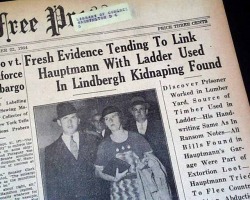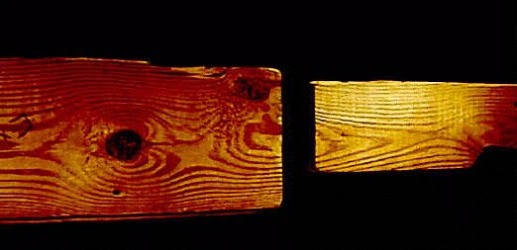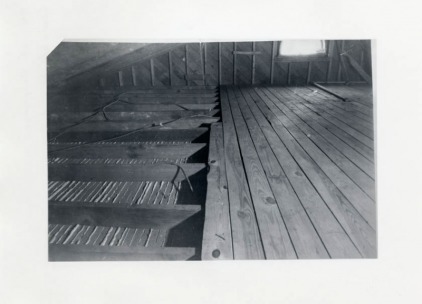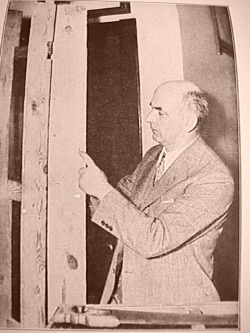The Ladder
One of the key pieces of evidence in the trial was a ladder that was found outside the Lindbergh home. Wood expert, Arthur Koehler, testified that the ladder was made of wood from a lumberyard in the Bronx, New York, not far from Hautpmann's home, and that one of the boards probably came from the attic in Hauptmann's house.
The Trial
by Jen Bryant
The Trial
by Jen Bryant
The key evidence tying Hauptmann to the actual kidnapping was a section of attic floor board taken from Hauptmann's Bronx apartment that precisely matched the grain of wood used for "rail 16" of the ladder found left at the kidnap scene. Moreover, rail 16 had four rare square nail holes that matched the nails used in Hauptmann's attic. Several jurors said after the trial that wood evidence was the most significant in proving Hauptmann's guilt.
by Douglas Linder
by Douglas Linder
Arguments from the LKH Public Forum
Click the links below to view images of the ladder.
Comparison of wood from Hauptmann's home to ladder
Broken ladder rung with dowell
Hauptmann's attic floorboard is to the left of the ladder
Ladder exhibit at Trenton Police Museum
Comparison of wood from Hauptmann's home to ladder
Broken ladder rung with dowell
Hauptmann's attic floorboard is to the left of the ladder
Ladder exhibit at Trenton Police Museum
The ladder
Insp. Lewis J. Bornmann of the New Jersey State Police discovered a missing rafter in Hauptmann's attic that corresponded to one of the uprights of the kidnap ladder. Koehler confirmed that the missing length of lumber matched, even to nail holes, the bottom section.
Eventually, the ladder became a crucial item of evidence. Schwarzkopf enlisted the aid of wood experts, the most enterprising of whom was Arthur Koehler, of the U.S. Forest Products Laboratory in Madison, Wisconsin. He had written Lindbergh and volunteered his services. From slivers sent to him, he was able to determine that the ladder was constructed from pine from North Carolina, Douglas fir from the West, birch, and Ponderosa pine. Remarkably, Koehler was able to trace some of the ladder lumber from a mill in South Carolina to a lumber dealer in the Bronx.
The ladder was both crudely and professionally constructed. Some of the joints and connections showed the work of a carpenter, while the pieces of wood that made up the ladder seemed to have been gathered from a variety of sources.
by Russell Aiudo
The ladder was both crudely and professionally constructed. Some of the joints and connections showed the work of a carpenter, while the pieces of wood that made up the ladder seemed to have been gathered from a variety of sources.
by Russell Aiudo
Lieutenant Lewis Bornmann, identified a ladder in the courtroom as the one he had discovered on the night of the kidnapping lying seventy-five feet from the Lindbergh home.
by Douglas Linder












